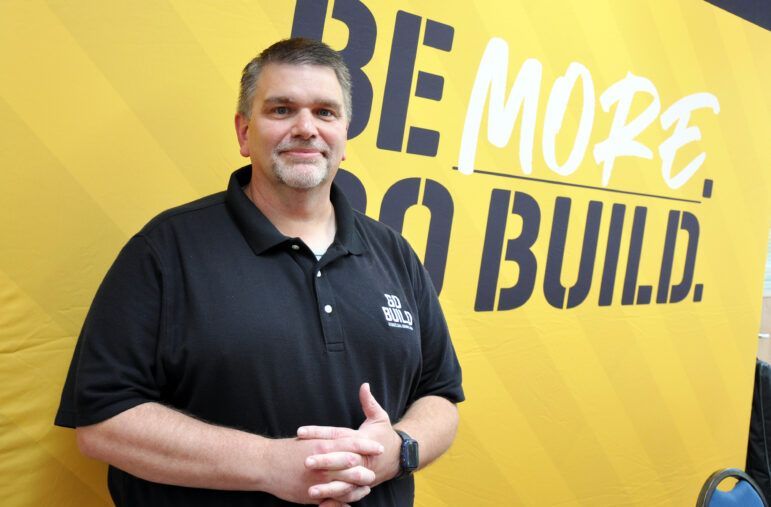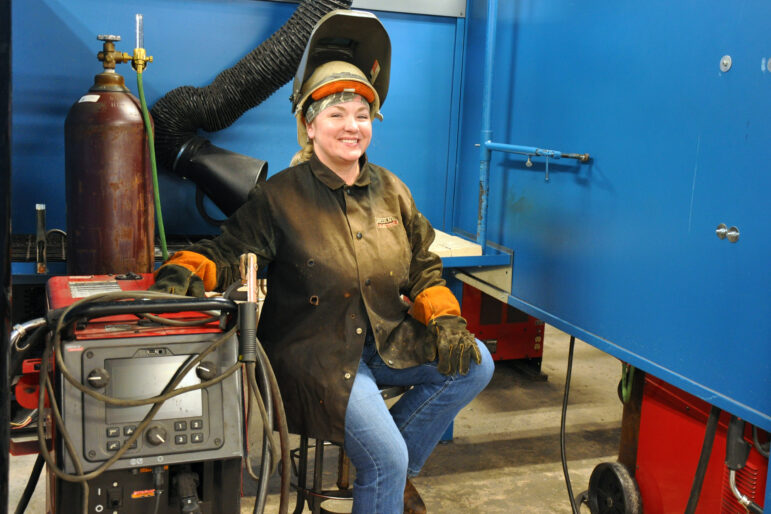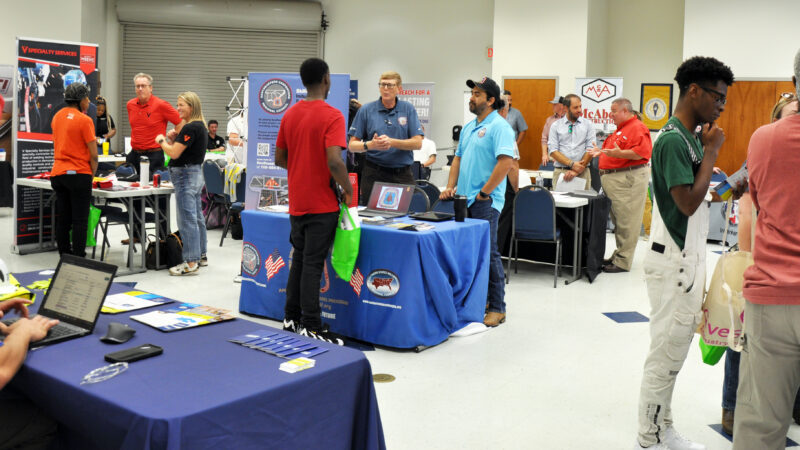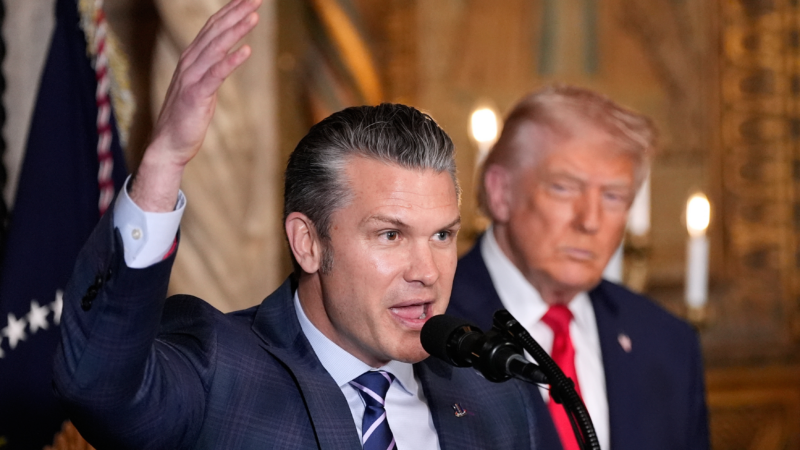Alabama’s construction industry is in dire need of workers. Here’s how companies are responding
Representatives of Alabama-licensed construction companies and trade unions talked with job seekers about open positions and career opportunities.
By Olivia McMurrey
Pop-up banners and tables strewn with logo-covered materials lined the walls of a large room during a late-summer hiring event at Lawson State Community College in Bessemer. Employers and trade-union representatives stood ready to recruit job seekers.
While it looked like a regular career fair, organizers designed the event to address an urgent problem: a construction-workforce shortage that is reverberating throughout Alabama. Every employer there had open positions to fill immediately – and above-average pay and benefits to offer.
Undreya Dortch, a graduate of Lawson State’s welding program, approached Dunn Construction’s booth and asked Amber Kinney, vice president of human resources and equal employment opportunity officer, if her company had any entry-level jobs. Kinney said it did.
“We would start you out at minimum welding, and then we would give you the training that you need,” she told Dortch. “I think you would be fantastic as a pipe welder.”
“I’m trying to get there,” Dortch said. “Hopefully.”
Later, Dortch explained she needs to build her confidence.
“Even though I graduated and I have a skill, I want to start at an entry level so that I can get more hands-on, in-the-field experience,” she said.
The skills Dotch already has are desperately needed. Many companies are hiring people with no background in construction and providing training themselves.
Workforce challenges
Nationally and in Alabama, a construction-workforce shortage has stretched for decades, after multiple generations were ill- informed about trade career paths. Now, as increased demand after the pandemic shows no signs of slowing and as billions of dollars in federal funding for infrastructure and manufacturing projects flows to states, the problem is growing.

Jason Phelps, executive director of the Alabama Construction Recruitment Institute, which the state Legislature established in 2009, said building the industry’s workforce requires clearing a multi-layered hurdle.
“When you’re talking about the challenge of getting skilled people in there and then you add a layer on top of it, with our aging workforce and people retiring, and then you throw on a third layer of, oh, we’re adding a thousand jobs a year to the construction industry in Alabama – that’s where our challenge has been,” Phelps said.
The shortage of commercial and industrial construction workers affects all Alabamians – in ways ranging from the roads we drive on and the facilities we work and learn in to the electric grid we depend on and the career opportunities we have. That’s because the health of a state’s construction workforce impacts its entire economy, says Jerry Grissom, board chairman of ACRI and vice president of labor relations and workforce development for Alabama Power Company.
Companies have to know there’s a workforce that can build facilities in a reasonable time frame before they commit to locating or expanding operations, he said.
“And when Alabama is out competing for industry growth, it gives a perception that maybe the workforce is not here,” Grissom said.
This is why the hiring event at Lawson State was so important. Officially, the event was a project of Go Build Alabama, an initiative of ACRI. But numerous local and statewide organizations came together to make it happen. They included the Alabama Construction Industry Craft Training Program, the Economic Development Partnership of Alabama and ALEX, its mobile workforce unit. Their leaders know construction companies are delaying or passing up opportunities to bid on projects because of labor-supply concerns.
How companies are being affected
Kinney says that’s the case for Dunn Construction, a paving and aggregates business that operates within a 60-mile radius of Birmingham.
“If we had people that were skilled to come in and just jump straight on a piece of equipment or run a crew, we could take on more work,” she said. “It doesn’t just affect us as a company, it affects everybody in the public in getting to and from places.”
Potential solutions include not only in-person events like the one at Lawson State but also digital tools such as an online job board Go Build launched this past summer.
At each of four stops along the hiring fair route, participants could register on the job board. Phelps said it already included 50 employers, 60 to 70 job listings and 900 career seekers.
“It’s been a huge success right out of the gate,” he said.
Free training and high earning potential for workers
Employers requested the job board, but it’s a big deal for would-be employees, too. From a worker’s perspective, the labor shortage represents possibility – a chance to earn a good living, with benefits, in a state that ranks 46th in the nation based on average annual wages.
Industry leaders said people going into many skilled-trade careers can make $60,000 to 80,000 per year relatively quickly right out of high school or through apprenticeships where they earn as they learn. Those incomes can rise well into six figures.
And training is often free. Opportunities are so enticing that people with four-year degrees or skills in other areas are finding a home in construction. Alana Willingham-Brown, a welding instructor at Lawson State, is one example. After getting a bachelor’s degree in Spanish translation and interpretation in 2008, she worked in an office for six months.

“I was making $11 an hour doing the job of three departments in two languages,” she said. “My first job out of welding school, I was making $19 an hour. It’s just a higher pay scale than what you’re seeing offered in office jobs.”
And a higher pay rate compared to many occupations women have traditionally held.
Efforts to attract women to construction
This hasn’t gone unnoticed by those leading efforts to recruit people to Alabama’s construction industry. Women make up 51% of the population but only about 11% of the construction workforce nationally. Alabama is doing better, with women accounting for about 18% of construction workers, according to the U.S. Census Bureau. That trend is accelerating, Phelps said.
“In just the last three or four years, women in construction are making up about 30% of new growth,” he said. “So we’re not quite at that 50/50 balance yet, but we’re moving in that direction.”
Willingham-Brown said she’s seen the difference, both as a woman working in the field and as a welding instructor.
“I see more women students come through my program,” she said. “Fifteen years ago, when I started, you couldn’t find ladies steel-toed boots or ladies work shirts or anything like that.”
Long-term outlook
In an overall job market that seems to be cooling, the consensus among construction-industry representatives at the hiring fair was that workforce demand in their field will remain strong. Grissom added that technology isn’t likely to erode those jobs.
“You’re always going to have a need for pipefitters, welders, ironworkers, boilermakers, electricians, laborers, operating engineers,” he said. “Machines will never take those jobs away.”
U.S. strikes another alleged drug-smuggling boat in eastern Pacific
The U.S. military said Monday that it had conducted another strike against a boat it said was smuggling drugs in the eastern Pacific Ocean, killing one person.
At least 5 killed after Mexican Navy plane on medical mission crashes in Texas
A small Mexican Navy plane transporting a young medical patient and seven others crashed Monday near Galveston, killing at least five people and setting off a search in waters along the Texas coast.
Trump announces plans for new Navy ‘battleship’ as part of a ‘Golden Fleet’
President Trump claims the warship will be "the fastest, the biggest, and by far 100 times more powerful than any battleship ever built." A month ago, the Navy scrapped plans to build a new, small warship, citing delays and cost overruns.
Federal judge says U.S. must give due process to deported Venezuelans
Judge James Boasberg said the U.S. denied due process to the Venezuelan men it deported to a prison in El Salvador after President Trump invoked the 1798 Alien Enemies Act.
Nearly two dozen states sue the Trump administration over funding for CFPB
The attorney generals say the Trump administration is refusing to accept funding for the Consumer Financial Protection Bureau, which could hurt consumers in their states.
A rift in MAGA has top Heritage Foundation officials leaving to join with Mike Pence
The exit of more than a dozen staffers follows turmoil at Heritage and the larger conservative movement over the role of right-wing influencers who've promoted antisemitic and other extremist ideas.









